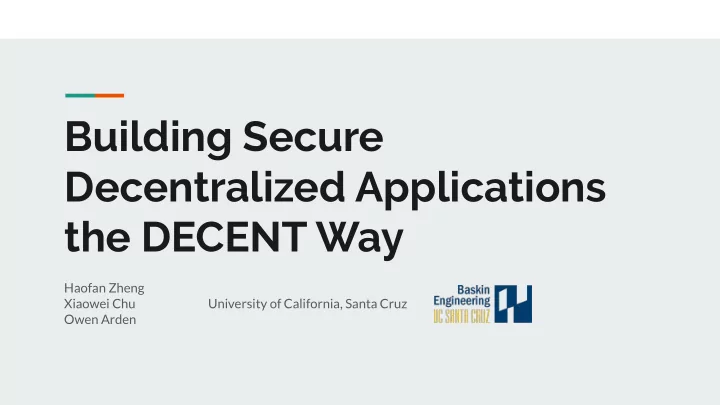

Building Secure Decentralized Applications the DECENT Way Haofan Zheng Xiaowei Chu University of California, Santa Cruz Owen Arden
Remote Attestation A process for the enclave to gain the trust of a remote service, so that the remote ● service will confidently reveal the secret to the requesting enclave In general, the remote service needs to ensure: ● The enclave is running on a legitimate platform ○ The enclave is the expected one (by comparing the hash of the enclave) ○
Problem Statement Remote attestation (RA) enables developers to ● deploy trusted code to enclaves on untrusted hosts and authenticate them remotely.
Problem Statement Remote attestation (RA) enables developers to ● deploy trusted code to enclaves on untrusted hosts and authenticate them remotely. However ● The RA protocol is complex ○ RA protocol Example - Intel SGX
Problem Statement Remote attestation (RA) enables developers to ● deploy trusted code to enclaves on untrusted hosts and authenticate them remotely. However ● The RA protocol is complex ○ Mutual authentication is non-trivial ○ Updating components is challenging ○
White List and Agreement For mutual authentication, a load-time white list is required ●
White List and Agreement But white list mismatch could lead to insecure flows ● Therefore, enclaves should trust other enclaves with the same white list ●
Self Attestation DECENT enclaves authenticate using certificates that ● bind a unique key pair to an enclave instance using a RA Remote attestation is done once at load-time, and ● periodically refreshed Use the unique private key to sign the certificate (which ● includes the white list)
How to Update Trusted Code/Components? Since white list are defined at load-time, updating would require restarting all ● components Verifiers are distinguished enclaves (defined by the white list) that may authenticate ● new enclave by signing their certificates
How to Update Trusted Code/Components? Example verifier: ●
How to revoke compromised keys or vulnerable code? If a TEE platform is compromised or an enclave is found to be vulnerable, the platform ● or the enclave must be revoked Revoked platforms will fail to produce fresh RAs ○ Revoking vulnerable enclaves requires mechanism similar to verifiers ○
How to revoke compromised keys or vulnerable code? Example revoker : ●
DECENT Handshake All the procedures are done during the ● TLS handshake
Case Study DECENT DHT ● DECENT Ridesharing ●
DECENT DHT DHT data stored is based on Chord, but it is a ● encrypted data store, where only the authorized application can access the data Advantages ● Data is encrypted by enclave's seal key, thus, no ○ centralized proxy or separate key management mechanism is needed Even if one node is compromised, the rest of data ○ remains secure Protects the integrity of the fingertable metadata ○
DECENT Ridesharing Inspired by the microservice architecture of ● Uber It evaluates that DECENT framework ● supports complex decentralized applications with multiple components Advantages ● Enclaves provide integrity of workflow and ○ billings Driver's or passenger's information only ○ revealed when matched Location and routes are private to drivers ○ and passengers *Uber microservice architecture: https://dzone.com/articles/microservice-architecture-learn-build-and-deploy-a
Conclusion DECENT framework supports building decentralized applications with enclaves ● Enclave authentication uses certificate backed by RA ○ Load-time white list ensures that only authorized components can join the system ○ Verifiers and revokers provide run-time modification to the set of authorized components ○ Implemented DECENT framework with Intel SGX ● Built DECENT DHT and DECENT Ridesharing to evaluate the DECENT framework ○ We are still working on experiment ○ Early result from simple experiment shows the overhead is lower than native SGX RA ○ protocol
Thank You! & Questions?
Recommend
More recommend